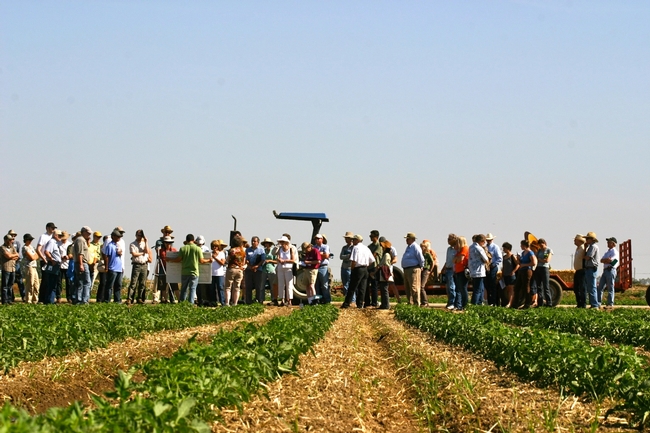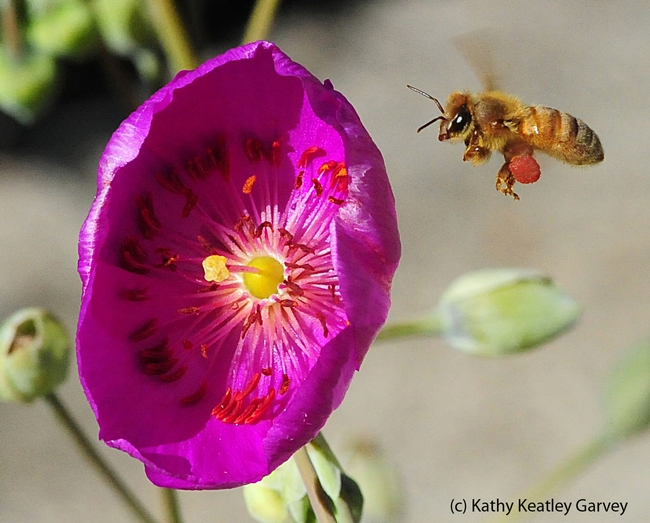UC Blogs
Reinventing agriculture at Russell Ranch
The size, scope and intensity of research at Russell Ranch Sustainable Agriculture Facility at UC Davis make the 300-acre experiment like no other in the world. The ranch’s unique focus on sustainability research is what draws producers, researchers and students to its annual Russell Ranch Sustainable Agriculture Field Day.
Located just west of the main UC Davis campus, Russell Ranch is a testing ground for the long-term sustainability of various farming methods. Research at the ranch focuses on fundamental components of agricultural production – energy, water and land resources – to help address the big questions of the future.
“The human population on the planet is going to increase from about 7 billion people to 9 billion people in 2050, which raises questions about food supply,” said Tom Tomich, director of the Agricultural Sustainability Institute at UC Davis, which houses Russell Ranch. “There is a great success story with agriculture and food production in the last 40 or 50 years – roughly doubling food supply. What that took, though, was doubling of nitrogen, tripling of phosphorus, a lot of advanced research. Now, are we going to be able to do this next doubling to feed the next two billion with business as usual? Or are we are going to have to discover new ways of combining sustainability with intensification to increase productivity?”
A majority of the ranch is comprised of a century-long research project devoted to better understanding the relationships between inputs like fertilizers and cover crops, and various indicators of sustainability. The rest of the ranch hosts a variety of other experiments conducted by researchers not involved in The Century Experiment.
Russell Ranch Field Day
Just as spring gives way to the heat of summer every year Russell Ranch hosts a field day to highlight the research in sustainable farming that is being conducted at UC Davis and primarily at the ranch. This year’s field day focused on issues involving nitrogen, water and climate change.
More than 160 growers, scientists and students learned about greenhouse gas emissions from agriculture, California’s new carbon market and soil microbial communities. Researchers from UC Davis and the company PureSense presented the results of research on a novel method for determining local, crop-specific water demand levels in real time to improve irrigation scheduling.
Thomas Harter, UC Cooperative Extension specialist in the UC Davis Department of Land, Air, and Water Resources, shared the results of a new report, “Addressing Nitrate in California’s Drinking Water,” which is the first comprehensive scientific investigation of nitrate contamination in two of the most agriculturally rich areas of California – the Tulare Lake Basin and the Salinas Valley. Harter and his team found that more than 90 percent of human-generated nitrate contamination of groundwater in these basins is from agricultural activity.
“First and foremost, this is about getting safe drinking water to people,” Harter said.
Problems like these inspire researchers at Russell Ranch to help agriculture develop in a way that will feed the planet’s growing population without creating health and environmental problems, Tomich said.
“California agriculture has always had this spirit of innovation. It has basically reinvented itself every generation. So, a lot of what we’re about here and throughout the Agricultural Sustainability Institute at UC Davis is asking: What’s going to be the scientific foundation for the next generation of California agriculture?”

Field day at Russell Ranch.
In the Blink of an Eye
In the blink of an eye, they visit the rockpurslane (Calandrinia grandiflora).Now you see them, now you don't.They're a sweat bee, a little...

Sweat bee, Halictus farinosus, prepares to leave one flower for another. (Photo by Kathy Keatley Garvey)

Sweat bee, Halictus farinosus, foraging in rock purslane. (Photo by Kathy Keatley Garvey)
UC Riverside calculations help demonstrate food safety
Robert Krieger, UC Cooperative Extension specialist in the UC Riverside Department of Entomology, calculated that a child could consume hundreds or even thousands of servings of many popular fruits and vegetables in one day and still not experience any negative health effects from pesticide residues.
To make the Pesticide Residue Calculator, Krieger analyzed the highest residue levels found on fruits and vegetables by the USDA and calculated the number of servings which could be eaten in one day without any negative health effects from the pesticide residues that may be present, according to a news release by the Alliance for Food and Fiber.
"At the end of the day, I think it's the responsibility of all parents and all adults to encourage children to eat their fruits and vegetables to help ensure they have long and productive lives," said Carl Keen, professor in the Department of Nutrition at UC Davis.
The Alliance for Food and Farming is a non-profit organization that works to provide a voice for farmers to communicate their commitment to food safety and care for the land, according to the organization's website.

The goal of the Pesticide Residue Calculator is to assure parents it is safe to serve children as many fruits and vegetables as they will eat, whether they are conventional or organic.
Getting the Red Out
"Where do bees get red pollen?" we were asked. "We've seen bees packing blood-red pollen at the entrance to a hive."Well, one flower that yields red...

Honey bee packing red pollen from rockpurslane. (Photo by Kathy Keatley Garvey)

Honey bee heading toward rock purslane. (Photo by Kathy Keatley Garvey)
A Little of This and a Lot of That
Today was quite interesting! I’m trying to do something (anything) in the back yard and the crows continue to caw: nothing like having your yard used as flight training school. Somewhere in the high grass near the shed is a “baby” crow who is not too sure about how these feathery things work. The term “baby” is not too descriptive – he/she is larger than the size a dove but young nevertheless!
I almost stepped on junior(ess?) yesterday while checking out the progress or lack of it I’m making in the side yard. (After 2 weeks previously of hacking and whacking at the rambler roses there, I’ve relocated a large raised bed with nothing in it. Well, almost nothing – “Bobbie James” decided to toss a runner in there and now it sits – denuded, but lethal all the same. Can’t dig it up – did I mention that I’ve been hung up at home for 2
months with a badly sprained knee (a knee, you say, surely you mean an ankle); nah, a knee and without 2 decently working knees, one simply doesn’t dig – trust me, brace and all—it doesn’t work! So I do what any other dedicated gardener does: I just stood there and glowered at it! The bush didn’t take the hint – it wants to bloom. Giving it another very short haircut, and it looks soo much better already.
But I did find a project: making 13 boxes for the upcoming Succulent Box planting class. Bruce, the woodworker, cut all the pieces of wood to size and I put them together! Ok, so I put them together with a lot of stand-by assistance in the form of advice. Bruce sat in the garage cum workshop (garage, yes right – couldn’t get a car in there with a shoehorn or wax from a candle.
I have found out more about 45 degree angles and how not to cut them than I care to know. When I get back to work and the State Parks Department goes into the box-making business, I’ll be in charge! But, I’ll graciously decline the job. Seriously,
I can now understand why these things are expensive – they are time consuming. But that not all I did...
For a long time now, I’ve wanted to catalogue my books so that I can not only find one when I need it, but also to crack down on duplicates. You know, when you find 2 or 3 of one book but not the one you thought you had and desperately need now!
The whole process only took 4 days – emptying shelves, entering, and replacing. Another time consuming job, but one that’s done and over. I have only 12 duplicate copies of
volumes now to get rid of. I’ll be sending Jennifer a list in case somebody needs additional books for their gardening libraries. It was actually rather nice to go through the books and see which were my mother’s first and which she bought for me.
Well, I’ll quit for now. My this and that ideas are coming to the fore and I need to write myself a note for future ventures outside. I sure hope the crow learns to fly in a hurry so that I can go out to the back without the constant cawing and dive bombing from mom and dad. Heck, I’ll teach him/her how to fly myself!

